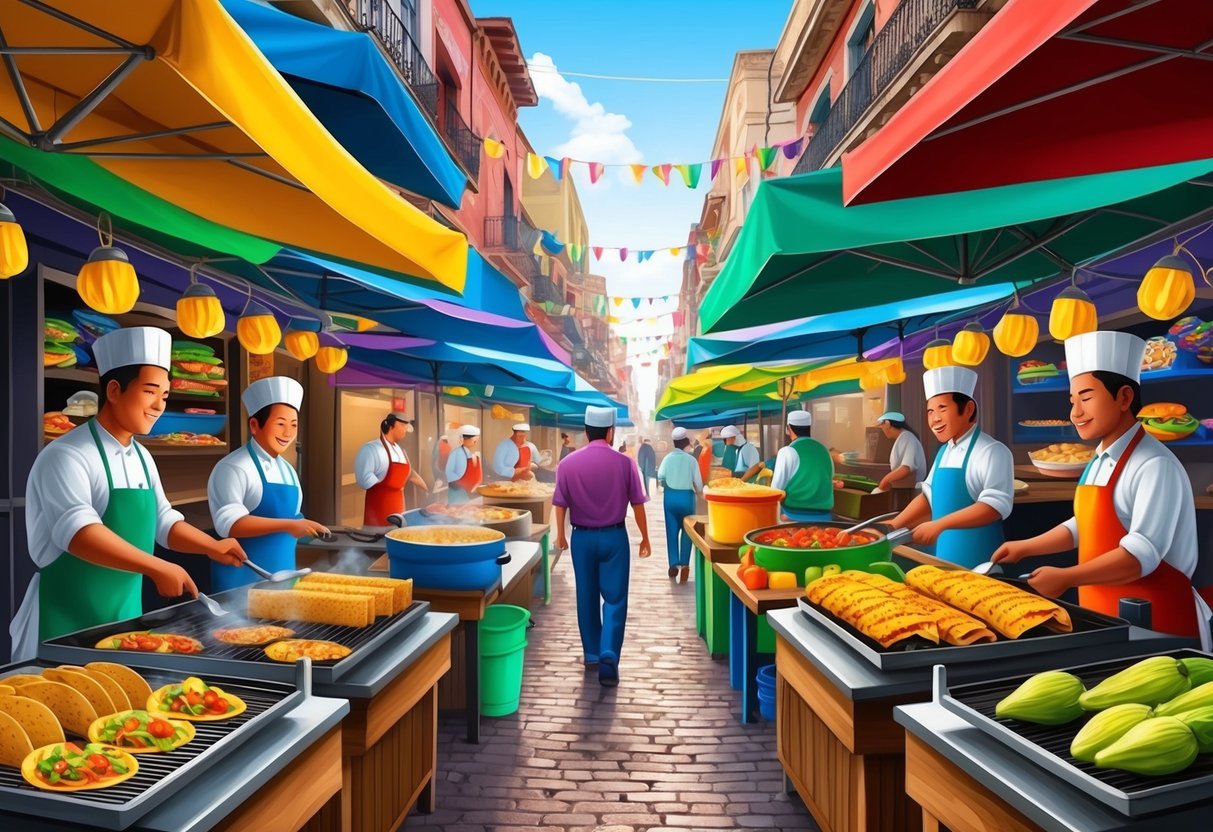
Savory Tamales and Traditional Variations
Tamales are a cornerstone of Mexican street food, known for their versatility and rich flavors. Distinct regions, like Oaxaca and Michoacán, have unique ways of preparing tamales, utilizing local ingredients and time-honored cooking techniques.
Oaxacan-Style Tamales
Oaxacan-style tamales stand out for their use of banana leaves instead of corn husks, which impart an earthy aroma and keep the masa extra moist. The masa is often seasoned with ingredients like lard and chicken broth, creating a rich, tender texture.
Fillings commonly include mole negro with chicken or pork, bursting with deep, complex flavors from dried chiles, chocolate, and spices. Many street vendors in Oaxaca prepare these tamales by steaming them in large pots, making them a popular choice at markets and festivals.
A key aspect is the variety of moles used, such as mole amarillo and coloradito, each providing a different flavor profile. The presentation is often unique, with tamales unwrapped at the table, releasing a fragrant steam that highlights their fresh, savory nature.
Michoacán Tamales
Tamales from Michoacán, especially uchepos and corundas, are distinct from other regions. Uchepos are made with fresh, sweet corn instead of dried masa harina, resulting in a naturally sweet, creamy tamale that pairs well with savory toppings like crema, cheese, or green salsa.
Corundas, another traditional dish from Michoacán, are typically triangular or star-shaped and wrapped in green corn leaves. Their masa is less seasoned than other varieties but often served alongside hearty dishes like pork with salsa or smoked meats.
These regional tamales reflect centuries-old indigenous methods, highlighting agricultural staples such as corn. Michoacán street vendors are known for serving these tamales piping hot, especially during local festivities and holidays where family recipes are passed down through generations.
Sweet Tamales
Sweet tamales offer a flavorful contrast to savory varieties, with fillings that include pineapple, raisins, cinnamon, and even strawberries. The masa is typically sweetened with sugar and sometimes tinted pink, making it visually distinct from its savory counterparts.
Commonly enjoyed for breakfast or as a festive dessert, sweet tamales are a staple at celebrations like Día de los Muertos and Christmas. Street vendors often display them alongside savory tamales, giving customers a choice of flavors.
Popular versions are wrapped in corn husks and steamed until tender, creating a soft, aromatic treat. The texture is moist and fluffy, mingling sweet and earthy notes that capture the diversity of traditional Mexican dishes.
For more on classic and creative fillings, see this guide to Mexican Tamales: Sweet or Savory.
Tostadas, Burritos, and Cemitas: Handheld Delights

Popular throughout Mexico and beyond, these handheld dishes take street food to another level with their creativity, rich flavors, and variety of textures. Local traditions and fresh ingredients come together to deliver authentic, satisfying experiences with every bite.
Tostadas
Tostadas are a classic Mexican street food made by lightly frying corn tortillas until crisp. They are then topped with a wide range of flavorful ingredients.
Refried beans, seasoned meats like shredded chicken or beef, chopped lettuce, diced tomatoes, avocado slices, pickled jalapeños, and crumbled cheese are all typical toppings. Traditional tostadas are often finished with a drizzle of Mexican crema and a sprinkle of cotija cheese for a salty, creamy finish.
For those wanting to create their own at home, a simple tostada recipe uses crispy store-bought or homemade tortillas as the base for creative toppings. See this homemade tostadas guide for inspiration.
Classic Burrito
The burrito is a staple of northern Mexican cuisine, featuring a large flour tortilla wrapped around a savory filling. Traditional burritos from Mexico typically contain just one or two ingredients, such as seasoned meat and refried beans, making them compact and easy to eat on the go.
The American-style burrito, by comparison, often packs in rice, cheese, lettuce, and multiple salsas. Key to a good burrito is the soft, pliable flour tortilla, which holds everything together without falling apart.
Many Mexican restaurant copycat recipes help home cooks recreate these satisfying handheld meals.
Cemitas from Puebla
Originating in the city of Puebla, cemitas are a distinctive Mexican sandwich defined by their unique sesame seed-topped rolls and bold fillings. The cemita roll is lightly crispy, slightly sweet, and robust enough to hold layers of sliced avocado, breaded milanesa (fried cutlet), Oaxacan string cheese, chipotle pepper, papalo herb, and more.
Papalo is a pungent, peppery leaf rarely found outside Mexico, but substitutes like fresh cilantro or arugula can be used. Cemitas are especially popular at Puebla’s street markets, where local ingredients and careful assembly result in a substantial, flavor-packed meal.
The contrasting textures of crispy bread, tender meat, and creamy avocado make the cemita a must-try for fans of Mexican sandwiches.
Burrito Bowl Variations
A burrito bowl offers the convenience and flavors of a burrito without the tortilla. It’s a favorite for those wanting a lower-carb option or simply more of their favorite fillings.
Bowls typically start with a base of rice or lettuce, then are topped with seasoned beans, grilled meats, fresh pico de gallo, guacamole, shredded cheese, and a choice of various salsas. Burrito bowls are highly customizable and easily adapted to suit vegetarian, vegan, or gluten-free diets.
Common add-ons include sautéed peppers, roasted corn, pickled onions, and a squeeze of lime. The layering of ingredients ensures every bite contains a mix of textures and flavors.
Many fast-casual chains feature burrito bowls, letting customers build their own with authentic Mexican ingredients.



